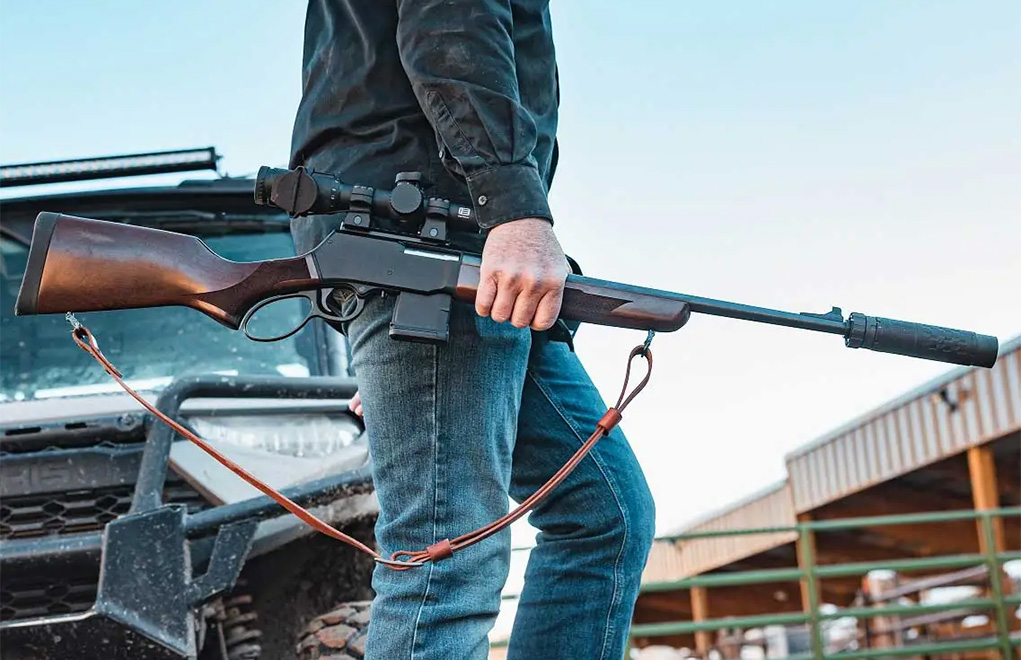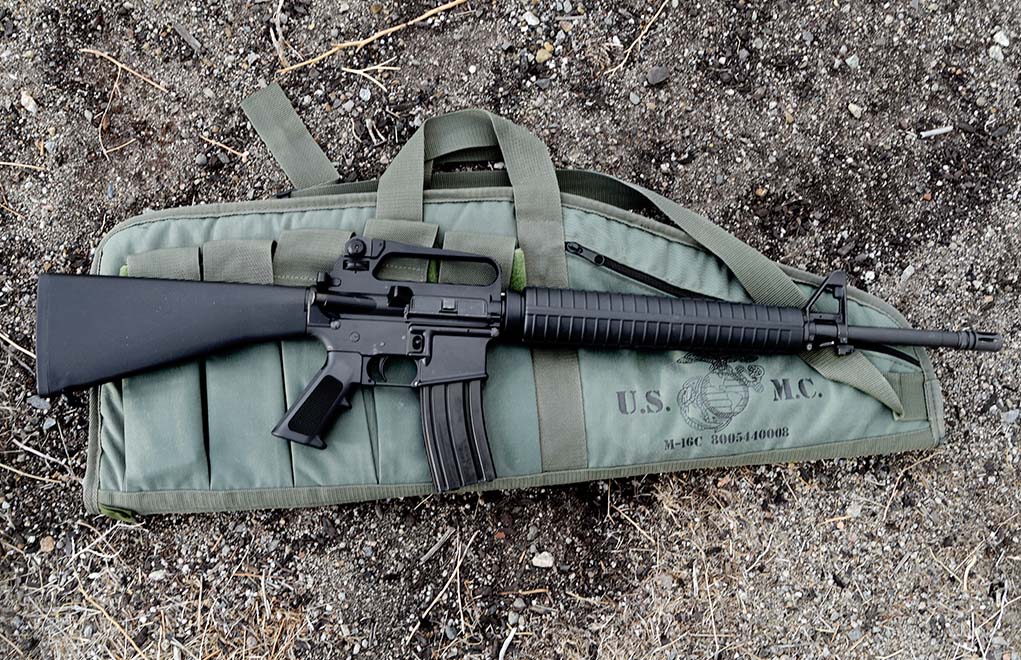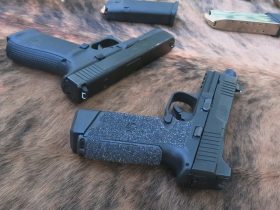Bushmaster has gone full retro with its XM15A2 fixed carry handle A2-style AR-15. Here we take one out to the range to see how it does.
ARs are a passion for some, and there are a lot of things you can do with a stripped lower receiver. The platform has truly evolved from its debut in the 1960s … and modern configurations can get pretty out there compared to Eugene Stoner’s original design.
Yet—sometimes—you want to go back to the way things were, whether it’s a simpler time, a better time in your life or just to be different. We see this with cars, motorcycles, cameras and stereo equipment. Heck, we even see it with video games.
So why not with ARs?
In celebration of the 50th Anniversary of Bushmaster Firearms and their new home in Carson City, Nevada, Bushmaster recently unveiled the XM15A2 to take you back to when the standard focused on iron sights and carry handles. A black phosphate-finished rifle sporting a chrome-lined barrel and bolt carrier will remind you of the original Bushmaster rifles made in Windham, Maine.

Bushmaster XM15A2 SPECS:
Caliber: 5.56 NATO/.223 Rem.
Barrel Length: 20 inches
Barrel Material: Phosphate, chrome-lined
Barrel Thread Pitch: ½:28
Twist Rate: 1:7
Weight: 7.9 pounds
Gas System: Rifle Length
Upper Receiver: A2
Bolt Carrier Group Finish: Chrome-lined phosphate
Bolt: MPI & HPT tested
Handguard: A2 w/ heat shields
Stock: A2 fixed stock
Grip: A2 pistol grip
Trigger: Mil-spec
Muzzle Device: A2 flash hider
Magazine Capacity: 30 Rounds
MSRP: $1,296.95
Bushmaster Reborn
Bushmaster Firearms Incorporated was founded by Mark Gwinn in 1974 in Bangor, Maine. The company changed hands two years later and relocated to Windham, Maine. In 1990, it was acquired by Quality Products Company.
In its heyday during the 1980s and 1990s, it was one of less than a handful of companies producing AR-15 pattern rifles. In 2006, Bushmaster was bought by Cerberus Capital and became a part of Freedom Group, which became Remington Outdoor Company in 2015. As Remington Outdoor Company entered a bankruptcy auction in 2020, Franklin Armory purchased the Bushmaster name and trademarks.
In 2021, Bushmaster Firearms Industries was off and running again. This time, however, it was on the other side of the country in Carson City, Nevada, offering basic flat-top AR-15 pattern rifles and carbines chambered in 5.56 NATO and .450 Bushmaster.
To celebrate the 50th anniversary, the company released the XM15A2 20-inch Fixed Carry Handle, chambered in 5.56 NATO—just like the original rifle in all dimensions that launched my career as a 17-year-old Marine rifleman in 1987.


Simpler Sights
If you’ve inhabited internet forums or social media groups during the past 10 years, you might have seen meme wars debating the use of iron sights versus optics. The XM15A2 is obviously geared toward the former with its high carry handle that houses a fully adjustable rear sight system that can be dialed in with an elevation wheel, allowing for range settings from 200 to 800 yards, and a side-mounted knob, allowing for windage adjustments.
This represented one of the most significant upgrades to the AR-15/M16 family when transitioning from the older A1 rear sight, which was adjustable for windage only by inserting a cartridge into the windage wheel dial and depressing a detent to make changes.
The end result turned the M16 into a target rifle. There’s some debate as to whether this was needed for field use by troops, but it definitely helps out on the target range.
If you’re unfamiliar with the A2 rifle, you get a fully adjustable windage knob without the need of a cartridge or tool to change your windage. The aperture sight has two settings, allowing you to flip either one into position.


One position has an unmarked hood, and the aperture measures approximately 0.070 inch in diameter. This is the default position for most firing situations. The rifle is zeroed with this aperture and the elevation wheel, which sits under the sight for distances out to 800 yards. In the Marine Corps, the default setting was 300 yards. The downside of using a relatively small rear sight aperture is that you get less light transmission through the aperture … and thus a reduced field of view.


The larger aperture, at approximately 0.2-inch in diameter, is marked “0-2” and features a windage setting index mark. This is often referred to as the Combat Sight by troops, as this aperture offers a larger field of view during battle conditions or low-light situations, and it can be used as a ghost ring for quick target engagement when visibility is limited. When flipped down, the engraved windage mark on top of the “0-2” aperture ring shows the dialed-in windage setting on a windage scale at the rear of the rear sight assembly. This aperture shouldn’t be used at a target range when shooting for the smallest possible groups.


There’s an elevation knob present as well, allowing you to dial in known distances in 100-yard increments up to 800 yards. The front sight post was widened slightly from the A1 and is adjustable with a tool in 1 MOA increments.
Not-So-Fancy Furniture
The more noticeable upgrades from the A1 to the A2 are the 1-inch longer butt stock, pistol grip with finger groove, and round handguards that install on top and bottom as opposed to left and right, making their removal and installation easier (as well as only having to inventory one part type as opposed to left and right sections).
Perhaps the most controversial change to some shooters was the heavy barrel in front of the handguards, which upped the weight of the rifle by about a pound. This was said to prevent troops from damaging the barrel when using it as a pry bar. This might just be lore, but having fired a Colt SP1 (A1 variant) and slinging in as I was taught in the Corps, I found myself pulling the skinny barrel to the left. There was no damage, but it screwed up the barrel harmonics enough that the heavier barrel was always a preferred standard in a working rifle build.
On the M16A2, the full-auto setting was replaced by a three-round burst setting. However, this doesn’t apply to this semi-auto counterpart.


A Better Build
Overall, the fit and finish on the Bushmaster XM15A2 20-inch Fixed Carry Handle is outstanding, from the coating on the exterior metal to bolt carrier group components. The company really outdid themselves with this build.
The sights move into position with positive affirming “clicks,” whether adjusting for windage or elevation. The factory military-grade trigger is good—much better than those found on any M16A2 we’ve fired. It could be improved with an aftermarket match grade from a number of manufacturers, especially if you’re going after longer range targets. But if you’re keeping it under 200 yards, this will serve you well.
I had a mini ammo can containing 120 rounds of American Eagle 62-grain 5.56 NATO FMJ on-hand. This was a similar load to most range ammo used in the USMC back in the 1980s when we became acquainted with the A2, so I took it out to give it a whirl.
I kept the range to 200 yards from the prone position and not off-handed or standing, to keep it as accurate as possible without allowing potential failings of the shooter.
The first string of shots landed about 4 inches to the right in a decent-sized group. It was easy to dial in; although the sub-20-degree temperature wanted you to start using Kentucky windage instead of doing it correctly, but we toughed it out. Thankfully, there was no Washoe Wind at the range to make life a little easier, this was just centering the sights.
Once we were dialed in, the groups were averaging 1 to 1.65 inches. This is definitely a rifle where you want to hit on all cylinders: trigger control, breath control and proper shooting position. In the Marine Corps, it was the basis of building a rifleman.
Of course, shooting the KD (Known Distance) Course in the Marine Corps was a longer affair drawn out for 1-2 weeks, snapping in, holding positions, using a sling to brace the rifle to the shooter, etc.
Perhaps we’ll attempt that at a future date, reaching out to 500 yards with iron sights because the rifle is fully capable of doing it.
The Bushmaster XM15A2 20-inch Fixed Carry Handle is a fully capable combat target rifle if there ever was one. You might never fire a shot in anger through one, but it would serve you well even as something to bring out to a long-range match … or just to have fun with at longer distances than you would with a typical AR.
Editor’s Note: This article originally appeared in the January 2025 issue of Gun Digest the Magazine.
More Retro ARs:


Next Step: Get your FREE Printable Target Pack
Enhance your shooting precision with our 62 MOA Targets, perfect for rifles and handguns. Crafted in collaboration with Storm Tactical for accuracy and versatility.
Subscribe to the Gun Digest email newsletter and get your downloadable target pack sent straight to your inbox. Stay updated with the latest firearms info in the industry.
Read the full article here















![Best Tactical Lever-Action Rifles [Field Tested] Best Tactical Lever-Action Rifles [Field Tested]](https://gundigest.com/wp-content/uploads/tactical-lever-action-rifle-feature.jpg)


Leave a Reply